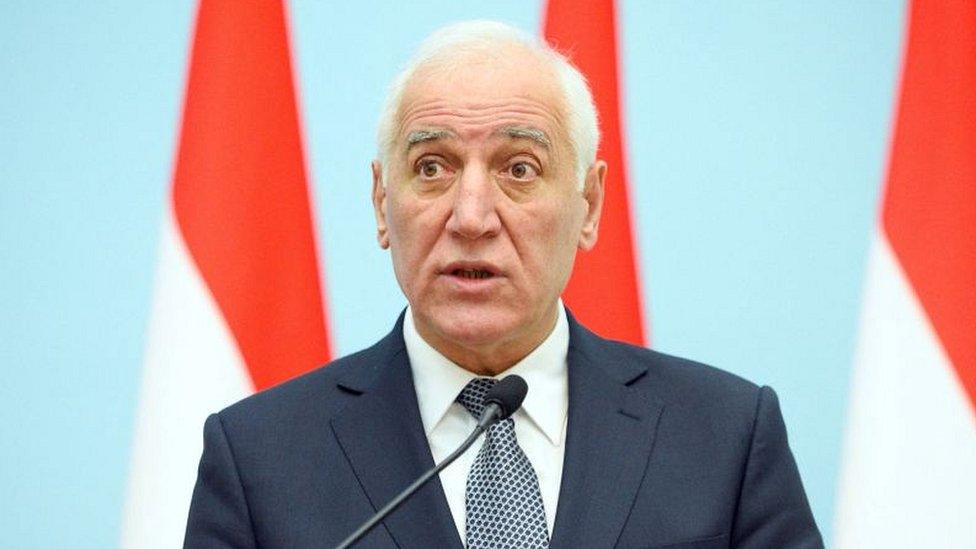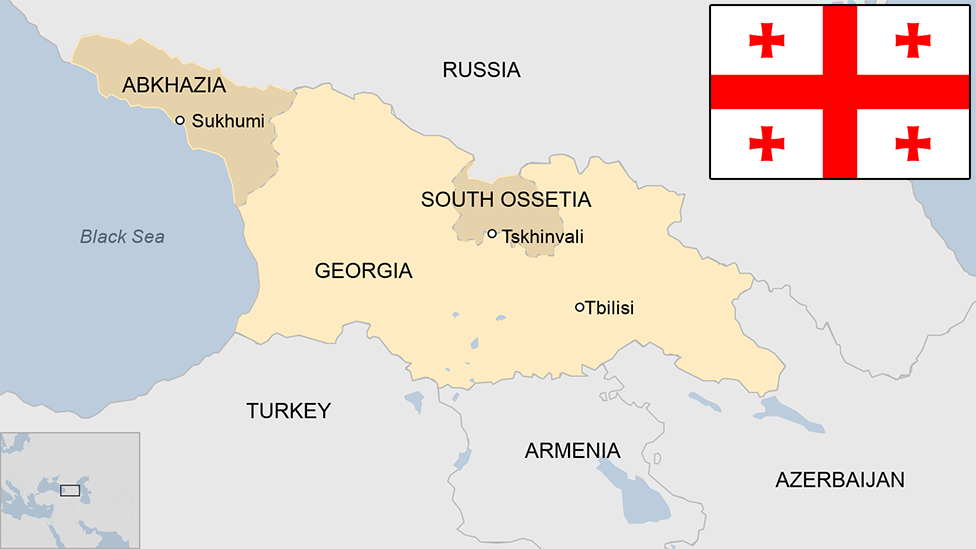Armenia country profile
- Published
This page is no longer being updated. It was last updated on 30 January 2024

A landlocked country in the Caucasus with Turkey to the west, Georgia to the north, and Azerbaijan to the east, Armenia boasts a history longer than most European countries.
After independence from the Soviet Union in 1991, Armenia quickly became drawn into a bloody conflict with Azerbaijan over the mainly Armenian-inhabited Nagorno-Karabakh region.
One of the earliest Christian civilisations, Armenia's first churches were founded in the fourth century. In later centuries, it frequently oscillated between Byzantine, Persian, Mongol or Turkish control, as well as periods of independence.
Read more country profiles, external - Profiles by BBC Monitoring, external
REPUBLIC OF ARMENIA: FACTS
Capital: Yerevan
Area: 29,743 sq km
Population: 3.0 million
Language: Armenian
Life expectancy: 72 years (men) 79 years (women)
LEADERS
Prime minister: Nikol Pashinyan

Opposition leader Nikol Pashinyan was elected prime minister by parliament in May 2018 after he spearheaded weeks of mass protests against the ruling party, transforming the country's political landscape.
He had piled pressure on the then ruling Republican Party through an unprecedented campaign of civil disobedience, leading to the shock resignation of veteran leader Serzh Sargsyan a week after he had shifted to the newly-empowered role of prime minister after ten years as president.
In December 2018 Mr Pashinyan called a snap election to remove the Republican Party majority in parliament, and his My Step Alliance won overwhelmingly.
Mr Pashinyan promised to maintain Armenia's strategic alliance with Russia.
But he faced calls for his resignation in late 2020 after agreeing to a Moscow-brokered ceasefire with Azerbaijan, which had made major gains in fighting to recapture Nagorno-Karabakh and Azerbaijani territory around it.
President: Vahagn Khachaturyan

Following the resignation of President Armen Sarkissian in January 2022, Khachaturyan was elected president by the Armenian parliament in the second round of voting. He took office in March 2022.
The post is a largely ceremonial one. Voters in a 2015 referendum backed constitutional changes reducing the powers of the president in favour of the premiership.
MEDIA
The political changes in 2018 had a profound effect on the media, with the main TV stations becoming largely free of state control.
But the media remain prone to political polarisation and a lack of financial independence.
TV is the leading medium, although less so among younger audiences.
The internet is a forum for political debate. Facebook is the top social platform.
TIMELINE

Armenia became the first country to adopt Christianity in about 300AD
Some key events in Armenia's history:
6th Century BC - first Armenian established under the Orontids as part of the Achaemenid empire.
190BC onwards - Kingdom becomes fully sovereign.
95-66BC - Under Tigranes the Great, Armenia becomes the most powerful kingdom east of the Roman Republic.
301AD - Tiridates III of Armenia makes Christianity the state religion.
428 - Armenia becomes part of the Sasanian empire.
c, 660-750 - Christian Armenia is absorbed into the Umayyad Caliphate.
884 - Armenia regains its independence under Ashot I.
1045 - Byzantine empire conquers Armenia.
1071 - Seljuk Turks defeat the Byzantines and conquer Armenia following the Battle of Manzikert.
12th Century - Armenian drive out the Seljuks and establish a semi-independent principality.
1230s - Mongols conquer Armenia.
16th Century - Armenia divided between Ottoman empire and Iran's Safavid dynasty.
1813-1828 - Iran forced to cede eastern Armenia to Russia following the Russo-Persian War of 1804-13 and the Russo-Persian War of 1826-28; western Armenia remains under Ottoman control.
1890s - Armenian Revolutionary Federation, or Dashnaks, became active within the Ottoman Empire. Their aim is both political reform and the wider goal of creating an independent Armenia.
1894-96 - Ottoman sultan Abdul Hamid II organises massacres of Armenians in response to growing Armenian political pressure, killing between 80,000-300,000 people.
1915-1917 - Between 300,000 and 1.5 million Armenians are massacred or deported by the Ottoman government from their homeland in Anatolia to present-day Syria. Armenia and many historians consider the killings an act of genocide. Turkey says killings occurred on both sides and denies that those suffered by Armenians amount to genocide. The topic remains a highly sensitive issue.
1918 - Independent Armenia emerges from defeat of Ottoman Empire in World War One, but is incorporated into the Soviet Union four years later.
1989 - Conflict over Nagorno-Karabakh begins with Azerbaijan.
1991 - Armenia declares independence.
1994 - Armenia, Azerbaijan and Nagorno-Karabakh sign a ceasefire accord. Ethnic Armenians remain in control of Karabakh.
2009 - Armenia and Turkey agree on a provisional roadmap for normalising diplomatic ties, but subsequently fail to ratify the deal.
2015 - Armenia officially joins the Russian-led Eurasian Customs Union, having decided against signing a EU Association Agreement.
2018 - Long-standing Republican Party rules ends after mass protests.

2020 - Azerbaijan recaptures large amounts of territory around Nagorno-Karabakh. Some 3,000 Azerbaijani soldiers and 4,000 Armenian soldiers are killed in the conflict.
Russian peacekeepers are deployed to monitor a new Moscow-brokered ceasefire, and also to ensure safe passage through the region of Lachin - the so-called "Lachin corridor" separating Nagorno-Karabakh from Armenia.
2022 - Fighting breaks out between Armenian and Azerbaijani troops along the Armenia-Azerbaijan border, about 50 soldiers on each side are killed in the clashes.
2023 - Following a months-long Azerbaijani blockade of the Lachin corridor, Azerbaijani forces rapidly overwhelm Nagorno-Karabakh troops and seize the region after 24 hours of fighting. The majority of ethnic Armenians flee.
2024 - Nagorno-Karabakh is formally dissolved.

Mount Ararat is an Armenian national symbol. It lies tantalisingly close just beyond the country's borders
Related topics
- Published22 August 2023

- Published25 March 2024

- Published31 December 2024

- Published13 February 2024

- Published14 October 2024
